Recent Storm Damage Posts
Tips for a Safer Recovery After a Storm| SERVPRO of Bellevue
6/22/2024 (Permalink)
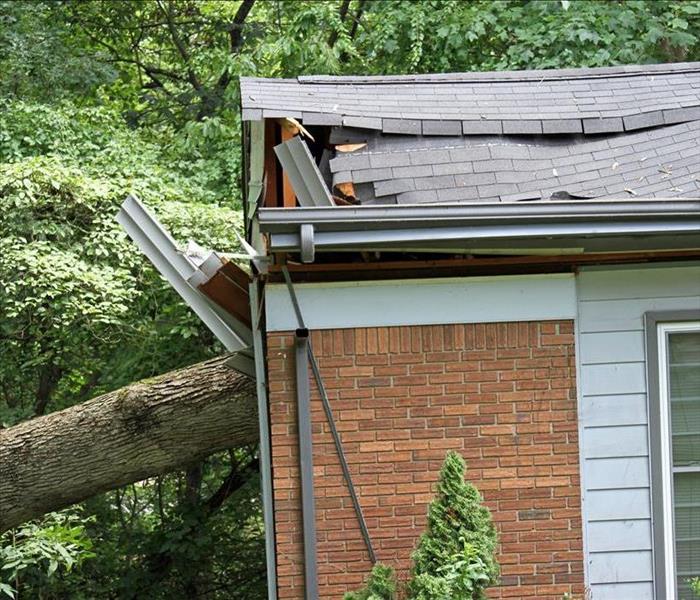 When an unexpected disaster takes your home by storm, you are not alone. SERVPRO of Bellevue is here and wants to help. Call us today!
When an unexpected disaster takes your home by storm, you are not alone. SERVPRO of Bellevue is here and wants to help. Call us today!
Storms can come in all shapes and sizes around here. Whether a coastal storm blows in off the ocean unexpectedly or an intense wind surge takes us by surprise, we could all be caught off-guard by the severity of the weather and our homes can suffer as a result.
Rain, wind and hail can cause serious damage to our homes and properties, and oftentimes, there isn’t much we can do while the storm rages on. Follow these tips to help guide you through the next severe storm situation if your home suffers damage.
After the Storm Passes
Hunker down in your safe shelter location and stay there until the coast is clear. That doesn’t necessarily mean once you hear the storm fading away that it’s safe to get out, though!
Storms can come in waves, and the next could very well be on the horizon. Stay connected to the forecast and your weather radio and only exit when the weather warning has expired.
Once you are able to get up and assess the situation, bring your phone and weather radio with you so you can stay connected and call for help if you run into any issues. Put on sturdy shoes and walk carefully in case you encounter broken glass, loose nails or unsteady floorboards.
Now is also the perfect time to connect with any family members that weren’t home when the storm came through. It is also a kind gesture to check on your neighbors, as storms can impact homes and people differently. After you determine that everyone is safe and accounted for, get SERVPRO of Bellevue on the phone.
How We Help You Recover
Suffering storm damage may be an emotional experience, especially if any sentimental items or possessions were damaged in the process. While you may still be a little shocked, it is important that you take action immediately to start the recovery process. The longer your home is exposed to the elements, the higher the risk that your spaces suffer from further damage.
We are proudly locally owned and operated, which allows us to be at your home quickly, but we do need to travel there! While you wait for us to arrive, we encourage you to take some preventive steps to secure your home. Remove any undamaged possessions from the affected area and lay tarps over any furniture if it is still actively raining or drizzling. We will do this more extensively when we arrive, but it never hurts to start the process right away.
Our first goal is to finish securing your home as soon as we arrive. We will secure tarps over exposed parts of your roof and walls to keep out the elements and we will also board up any broken windows or busted doors. Then we will get started removing standing water and addressing your structural repairs. If fragile possessions like documents or upholstery were damaged, our team can expertly handle the restoration of these items as well.
SERVPRO of Bellevue is always Here to Help® you navigate storm damage. Contact us today.
Overcoming Threatening Flood Damage to Bellevue Homes
8/8/2022 (Permalink)
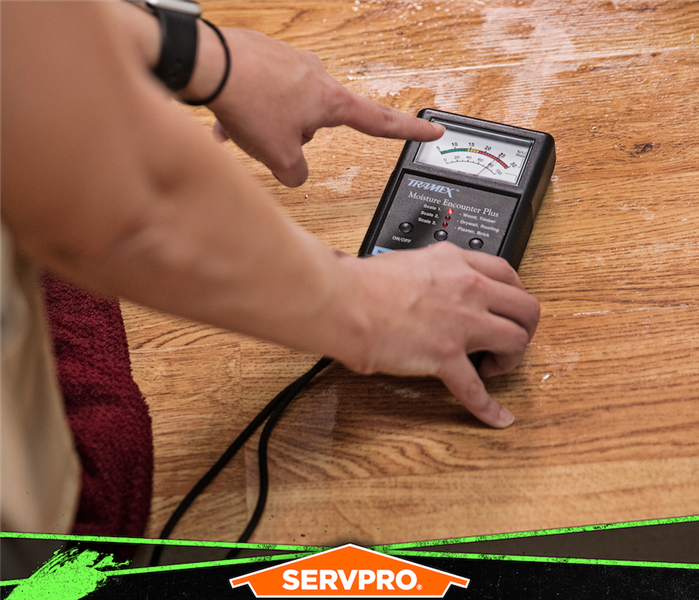 SERVPRO flood damage restoration specialists have the training and experience for all phases needed for your home.
SERVPRO flood damage restoration specialists have the training and experience for all phases needed for your home.
The Focuses of Flood Damage Cleanup
Flooding is a fast-paced threat to your home. As leading restoration professionals, we have specific mitigation and recovery objectives that must begin as soon as possible to limit out-of-pocket expenses. Emergency services can include:
- Containing the impact
- Repairing structural concerns
- Protecting personal belongings
- Cleaning exposed surfaces
- Drying the structure
Containing the Floodwater
Containment is one of the initial focuses of cleaning up flood damage in Bellevue homes and businesses. Preventing surface water movement and migrating moisture protects more of the structure and reduces the possibility of widespread microbial growth and contamination.
Preventing Harm to Contents
Personal belongings can quickly find themselves in the damage path of migrating flood loss effects. Standing water and potential contaminants can render contents unsalvageable, so prioritizing relocation and preserving these objects is vital.
Emergency Repairs and Building
Our general contractor license allows us to complete needed controlled demolition and emergency repairs, which begins as soon as we arrive. We can reconstruct damaged utilities or seal/patch over structural vulnerabilities allowing floodwater penetration. Repairs might include rebuilding the roof, replacing siding, or patching breaches in the foundational masonry.
Effective Drying for Flood-Damaged Materials
Drying is one of the foundational elements of every water and flood damage scenario. We have hundreds of air movers and dehumidifiers specifically tasked with evaporating surface moisture and managing humidity. We can also utilize portable heaters to increase the temperature of wet surfaces for faster drying and a greater relative humidity capacity in the structure.
Surface Cleaning and Disinfection
Cleaning up impacted surfaces can be one of the best methods of combatting the possible contamination associated with flooding. We have potent disinfectant agents, chlorines, and phenolics to eliminate surface soiling and microbial threats.
Flooding can be a compromising disaster for your home. Our SERVPRO of Bellevue West team gets cleanup started as soon as we arrive. Call now at (425) 454-3900.
Clyde Hill Homes Need Flood Damage Drying from Air Movers
8/8/2022 (Permalink)
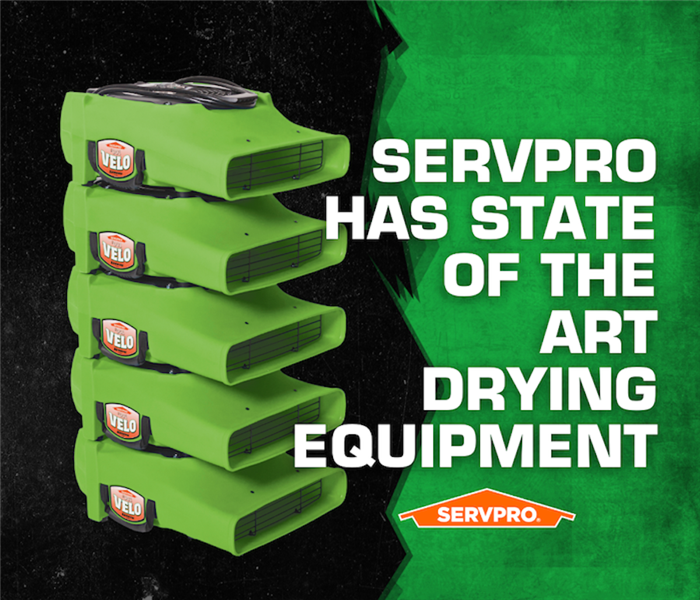 SERVPRO IICRC certified technicians are ready at a moment's notice. Call now!
SERVPRO IICRC certified technicians are ready at a moment's notice. Call now!
Flood Damage Is Mitigated with Air Movers
Flooding can be a widespread concern for your residence, especially when building materials and contents begin to absorb this migrating moisture. It is imperative to start drying approaches as soon as possible, and air movers are among the most important tools for this process. Varieties of this equipment include:
- Axial
- Centrifugal
- Low-Profile
Continuous Beneficial Airflow
The most direct benefit of air movers in recovering flood damage in Clyde Hill homes is the manipulation of air. Many materials are affected by saturation and absorption, but air movers provide a steady dispersal of focused warm air against damp surfaces to evaporate the moisture. SERVPRO technicians can frequently move these high-velocity units to provide a stable output of effective evaporative drying.
Raising Vapor Pressure
Vapor pressure is an essential principle of effective drying in residence. Increasing the temperature in the affected room by using air movers to circulate the warmth increases the drying process overall in the designated workspace. When temperatures of trapped moisture increase, kinetic energy and molecular movement also increase. Vapor pressure increases in this scenario as more efficient vaporization of surface moisture occurs.
Removing the Vapor Barrier
When evaporation occurs, a natural barrier of cool air begins to form just above the material's surface. This boundary can prevent efficient drying. Air movers can help by blasting through this cool air barrier and continuing to impact the underlying wet surface. Centrifugal units are specifically designed to focus a blast of warm air at a designated point on the wall or ceiling to overcome this challenging layer.
Air movers are one of the most common drying tools used by our SERVPRO of Bellevue West team when removing surface water and trapped moisture. We can overcome several obstacles in the drying process with various types of these units. Do not wait to get mitigation started after a flood - call us now at (425) 454-3900.
Specialized Restoration Techniques for Clyde Hill Hardwood Floors Damaged by Flooding
5/19/2022 (Permalink)
 In the aftermath of a flood, not all building materials in Clyde Hill homes react in the same manner.
In the aftermath of a flood, not all building materials in Clyde Hill homes react in the same manner.
In the aftermath of a flood, not all building materials in Clyde Hill homes react in the same manner. Some exhibit remarkable resilience, while others prove less impervious to the ravages of floodwaters. For those fortunate homeowners with hardwood flooring, hardwoods tend to fare better in high-moisture situations. Nonetheless, the restoration of flood-damaged hardwood floors demands a unique approach.
The flood damage experts at SERVPRO®, serving Clyde Hill, routinely confront the challenge of restoring water-damaged hardwood flooring. These efforts are an integral part of our comprehensive emergency water damage services, encompassing everything from water cleanup and water damage repairs to biohazard remediation. Our hardwood restoration methods are specifically designed to prevent moisture-induced buckling and warping from becoming permanent. In pursuit of this objective, we employ the following strategies:
Swift Drying: We prioritize rapid drying, reducing relative humidity to the optimal range of 30-45%. Air movers are strategically positioned to facilitate air circulation both above and below the flooring.
Controlled Temperature: Interior air temperatures are raised to expedite evaporation once floor moisture levels fall below 16%.
Vapor Barrier Removal: Floor finishes that act as vapor barriers are either removed or penetrated using pin rollers to enable thorough drying.
Innovative Injectidry Systems: We utilize state-of-the-art Injectidry systems to force air beneath the flooring, promoting drying from underneath.
Once these comprehensive drying actions are executed, our SERVPRO technicians exercise patience until hardwood moisture levels drop below 12%. Upon reaching this crucial benchmark, meticulous sanding eliminates any remaining cupping and warping. The final step involves refinishing the sanded flooring, restoring it to a near-new appearance.
With this commitment to excellence, SERVPRO has earned its reputation as one of the premier flood damage restoration providers in the Northwest region. Therefore, when your residence experiences a flooding event, take comfort in knowing that your neighbors at SERVPRO are ready to assist. Contact us anytime at (425) 454-3900 for prompt and professional help.
Challenges in Remediating Flood Damage with Cinder Block Walls in Bellevue
5/5/2022 (Permalink)
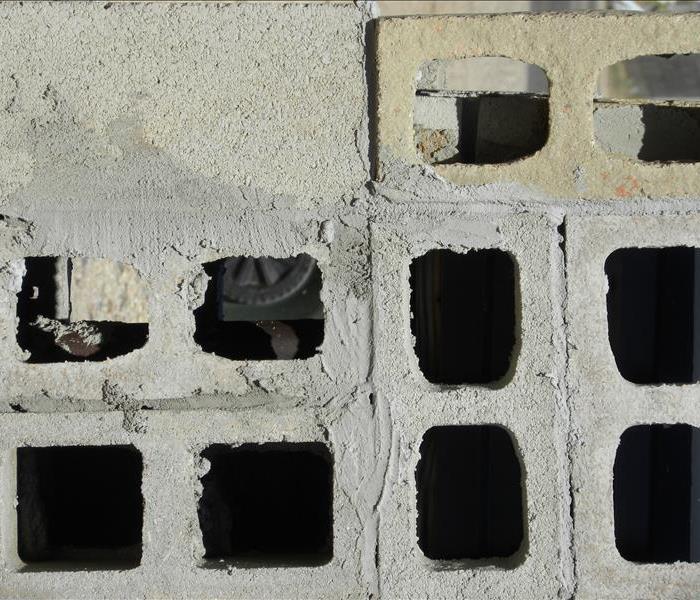 Persistent rain in the Northwest makes flooding a recurring issue, and Bellevue is no exception.
Persistent rain in the Northwest makes flooding a recurring issue, and Bellevue is no exception.
Persistent rain in the Northwest makes flooding a recurring issue, and Bellevue is no exception. Residents often grapple with the complexities of flood damage cleanup. Unfortunately, the process of drying can be notably affected by the building materials used in your home's wall construction.
At SERVPRO®, we recognize the unique difficulties involved in effectively remediating flood damage in Bellevue homes with cinder block walls. These walls can pose significant challenges for tasks such as biohazard remediation, basement flood cleanup, water extraction, and water damage repairs. However, our highly skilled technicians are well-versed in addressing these challenges efficiently. Some of the specific scenarios they've encountered that hinder the drying process in cinder block walls include:
- Aging block walls that have absorbed substantial environmental moisture over several years or even decades.
- Prolonged floodwater exposure leading to thorough permeation of cinder block structural elements.
- Blocks coated in semi-gloss or gloss paint, trapping moisture within walls and rendering standard drying techniques ineffective.
- Block walls filled with insulation materials like fiberglass, foam, cellulose, or vermiculite, making it difficult to maintain the necessary internal dry air circulation for moisture reduction.
- Walls incorporating concrete bond beams that impede or alter airflow within block cavities.
SERVPRO effectively addresses most of these issues by drilling holes in mortar joints near the base of affected walls, utilizing non-penetrating moisture meters to gauge drying completion, and subsequently patching the drilled holes.
In light of these challenges, remember to reach out to SERVPRO of Bellevue West at (425) 454-3900 when you require specialized flood damage assistance. We are always prepared to respond to your call.
Urgent Requirements for Flood Damage Extraction and Cleanup in Clyde Hill
4/21/2022 (Permalink)
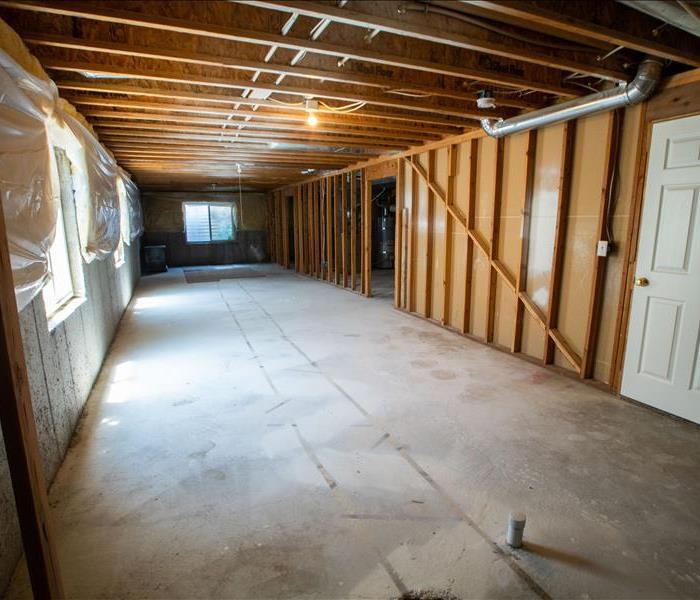 In the aftermath of flood damage, thorough cleaning of non-porous materials like concrete flooring and masonry units is imperative.
In the aftermath of flood damage, thorough cleaning of non-porous materials like concrete flooring and masonry units is imperative.
The basement of your Clyde Hill residence is susceptible to rapid flood damage when infiltrating water exploits vulnerabilities in your home's structural integrity. The aging elements, such as the foundation's masonry units, may permit floodwater intrusion. Swift action is essential to address flood damage and minimize losses, particularly for items stored in the lower level.
Addressing Standing Water Concerns
One of the primary challenges posed by flood damage in Clyde Hill homes is the accumulation of standing water. Water can accumulate swiftly in this lower area, reaching depths of several inches or even feet. Our arsenal includes multiple water removal units, including potent truck-mounted extractors capable of efficiently handling pooled floodwater and debris removal.
Utilizing Air Movers for Drying
Air movers stand out as one of the most formidable tools in our inventory for managing moisture and water-related issues following flood incidents. Strategic placement and consistent operation of these units facilitate the efficient evaporation of surface moisture damage by introducing dry, warm air to damp building materials.
Thorough Surface Cleaning
In the aftermath of flood damage, thorough cleaning of non-porous materials like concrete flooring and masonry units is imperative. Although the flooring may not necessitate demolition and removal, disinfection cleaning is essential to safeguard the property against the growth of harmful microbes and potential health hazards. A combination of mechanical action and our potent cleaning products effectively eradicates surface microbial and bacterial threats. The cleaning process revolves around three key principles: temperature, agitation, and chemical treatment.
Regardless of how swiftly flood damage encroaches upon and engulfs your home's basement level, our rapid response can safeguard both the contents housed in the lower level and the exposed structural elements. Don't hesitate to contact our dedicated SERVPRO of Bellevue West team today at (425) 454-3900.
 When an unexpected disaster takes your home by storm, you are not alone. SERVPRO of Bellevue is here and wants to help. Call us today!
When an unexpected disaster takes your home by storm, you are not alone. SERVPRO of Bellevue is here and wants to help. Call us today!






 24/7 Emergency Service
24/7 Emergency Service




